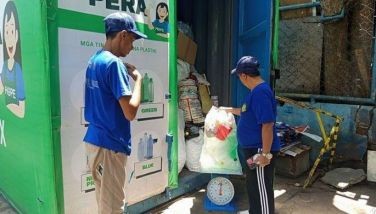Gardening in Containers
CEBU, Philippines - If there's a will, there's a way. Even city dwellers with limited spaces may still grow a garden if they want to. They can make use of rooftops, balconies, alleyways, sidewalks or whatever little space they have available - by planting in containers.
Curiously, some people find growing vegetables in containers more convenient and easier to tend than in actual garden plots. It's also a good - if not the only - alternative to difficult soil conditions (sand, stone, clay etc.) in most house yards in cities. Others find it to be a way to avoid sharing their harvest with animals.
Those who are new to growing vegetables in containers, or have had limited success, may try a few tips to help them succeed.
The best vegetables to grow in containers
Potatoes, lettuce, cherry and bush tomatoes, peppers, eggplants, pole beans, onions and herbs are just a few of the plants that can be grown in containers.
Ideal planting depth
Here are the minimum soil depths for healthy growth. If using a self-watering planter, less depth is okay.
.4-5 inches: chives, lettuce, radishes, other salad greens, basil, coriander
.6-7 inches: bush beans, garlic, kohlrabi, onions, Asian greens, peas, mint, thyme
.8-9 inches: pole beans, carrots, cucumber, eggplant, peppers, upland kangkong (stalk), parsley, rosemary
.10-12 inches: beets, broccoli, okra, potatoes, sweet corn, dill, lemongrass
Selecting a container
As a general rule, select as large a container as possible. Small containers dry out more quickly and need daily watering. Self-watering planters extend the time between waterings. But it's also wise to think about weight (once the pot is filled with wet soil and plant material it's going to be very heavy and hard to move around). Aesthetics is important, too, whether the appearance of the grown plant goes well with the look of the house and with the other pots. Even fabric pots are good for growing vegetables. The new, colorful Grow Bag line can add some whimsy to the vegetable garden.
Most importantly, the depth of the container to be growing in is a crucial consideration. Plants with deep root systems will be stunted and unhealthy if they don't have adequate space. The deeper the pot, the larger the reservoir of moist soil and the less often the need to water. The exception is a Self-Watering Planter where the depth of the planting area can be kept to a minimum because moisture is provided by a water reservoir below the planting area.
Where to place the planter
Most vegetables require six hours of sunlight per day. Salad greens and herbs can usually get by with less. Tomatoes, peppers, beans and other sun-lovers will appreciate as much sun as they can get. If the place is short on sun, putting the plants on caddies or adding casters is a good idea, so they can be moved during the day as the angle of the sun changes.
Wind is another factor to consider. Plants are happiest in a protected location where the wind doesn't batter and dry out their foliage. Using the shelter of a building or erecting a temporary windbreak made from portable fencing or fabric are good ideas. It also helps to arrange the pots so larger plants shield smaller plants. And clustering potted plants works to raise humidity levels, keeping plants more productive.
If using a trellis or some other type of support in the container, wind is a special concern. The pot must be heavy enough to stand the blows and the trellis secured to a railing or some other fixed upright.
The right soil
A good garden soil to fill the containers is a blend that will retain lots of moisture and resist compaction. A right blend may be attained by mixing good soil with the right amount of compost. Many gardeners swear to the good effect of putting rice husks into the mix.
Water
Vegetables require a consistent supply of water to perform their best. Inconsistent moisture causes lots of problems, such as blossom drop, poor root development, leaf curling, insect problems and rot. The best way to ensure that plants always have a consistent supply of water is to use a self-watering planter. Filling the reservoir every few days is all that's required. The plants absorb moisture as they need it.
Fertilizer
Even if organic is preferred, there's granular organic All-Purpose Fertilizer available at gardening supply stores. Regularly using fine compost helps as well. Plants perform so much better with fertilizer, particularly important when growing them in containers. The growing medium in the container has few, if any, nutrients. Also, containerized plants get watered a lot, and every time, some nutrients are washed from the soil. And given the fact that in a container garden lots of plants are packed into a small space, they really need extra support.
Plant that are good companions
Beans, carrots, squash; Eggplant, beans; Tomatoes, basil, onions; Lettuce, herbs; Upland Kangkong, onions.
Combinations to Avoid
Beans with onions and garlic; Carrots with dill or fennel; Tomatoes or squash with potatoes; Onions with beans and peas.
When combining several different types of plants in one pot, it's best to match plants that have a similar need for water and fertilizer. For example, rosemary, which likes hot and relatively dry conditions, would not be a good match with water-hungry cucumbers. To maximize space, you might want to combine a trailing plant with an upright plant.
Some plants actually grow better when grown near a compatible companion. On the other hand, some plants don't seem to grow as well when paired with certain plants. Sometimes the reasons are simple - carrots, dill and fennel are all in the same plant family and will compete for the same nutrients - but others are more mysterious.
(Source: www.gardeners.com)
- Latest






























